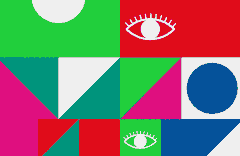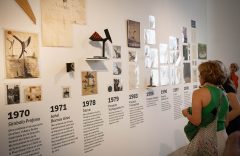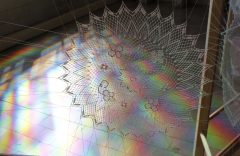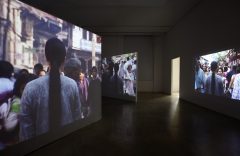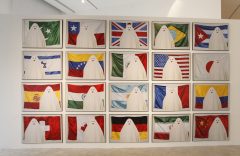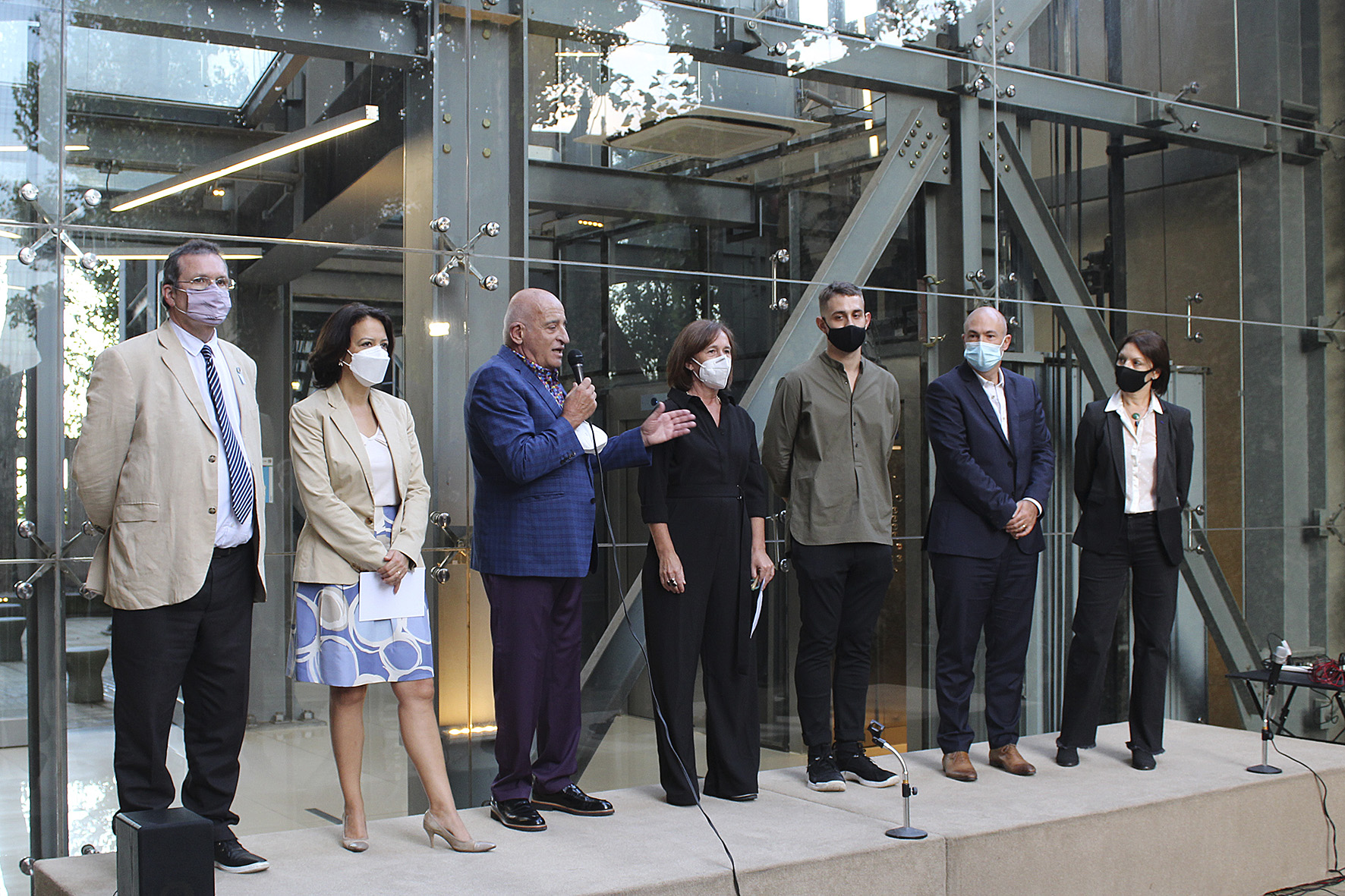
The opening was attended by the Minister of Culture of the Nation, Tristán Bauer, the French Ambassador, Claudia Scherer-Effosse, and the director of the Institut français d’Argentine, Lionel Paradisi-Coulouma.
The exhibition After Babel. Translations from the Río de la Plata was presented to the public at the
MUNTREF Center of Contemporary Art in the presence of cultural representatives from Argentina and France.
On a small stage set up at the entrance of the Hotel de Inmigrantes, the rector of the UNTREF and director of its Museum, Aníbal Jozami, welcomed the audience accompanied by the Minister of Culture of the Nation, Tristán Bauer, the French ambassador, Claudia Scherer-Effosse, the director of the Institut français d’Art Contemporain, the director of the Institut français d’Argentine, Lionel Paradisi-Coulouma, the art director of the MUNTREF and director of the Department of Art and Culture of the University, Diana Wechsler, and the curators Marina Aguerre and Leandro Martínez Depietri, from the Dr. Norberto Griffa Art and Culture Research Institut (IIAC).
In the audience were the director of the National Library, Juan Sasturain, the ambassador of Morocco, Fares Yassir, and some of the artists who take part in the exhibition, Cristina Piffer, Hugo Vidal, Sebastián Tedesco and Sebastián Pasquel, among them.
Tristán Bauer celebrated the opening of the exhibition and said that it is an example of how “the flame of culture continues to burn despite the difficulties”. The minister stated that in times of so much suffering “we know that there are places in the human soul and in society that we can only reach through the arts”. He also praised the fact that the exhibition promotes the connection between Argentina and France, and emphasized the importance of its being made from a public university. “Congratulations to those who carried out this exhibition, which will surely enrich everyone,” he affirmed.
Jozami said that there are different reasons that make this opening significant. “On the one hand because it shows how in a year of pandemic we have been able to continue working in all areas of the University, and on the other because it ensures the continuity of the collaboration with the French Embassy, with which we have been working for years on cultural issues and many others,” he said.
He also pointed out that it is very important that this exhibition, which praises translation, has been set up at the Immigrants’ Hotel, because “this building reflects Argentina’s multiculturalism; a multiculturalism that comes from our native peoples and from the migrations that ended up shaping what Argentina’s society is today.”
The Rector said that After Babel. Translations from the Río de la Plata upholds “diverse thought” and a “recovery of the different cultures”, in contrast “to the one-sided thought and global language”. He also thanked the representatives of the different public and private institutions that lent works and documents, especially the National Library.
During the ceremony, Jozami read a letter from French curator and linguist Barbara Cassin, from the Académie Française/CNRS, who was unable to travel due to the pandemic. In her letter, the curator said she regrets not being able to be there but that it is “comforting to know that this exhibition exists for the Good” and that “no place could suit it better than the Immigration Museum”. Cassin defined the exhibition as “a merry Franco-Argentine adventure”.
On her side, Claudia Scherer-Effosse reflected upon the problems faced by cultural institutions and artists in keeping culture alive during the pandemic. “The curatorial teams of this exhibition have worked together from a distance for months, and I want to highlight their work and dedication,” said the diplomat.
Likewise she praised her compatriot Cassin, whom she characterized as “an emeritus researcher, a very fine observer of cultures and languages who promotes diversity and respect in our world.”
Scherer-Effosse pointed out that “Babel is a way of preserving and discovering the importance of translation in our world, and Barbara Cassin pays a fair tribute to art with this exhibition.”
Finally, she highlighted the joint work generated by the exhibition: “It combines the excellence of the artistic and curatorial teams of the two countries”, and she concluded that “it is a perfect example of the cooperation lines that the French Embassy and the Institut français d’Argentine wish to promote,”.
Following the sanitary protocol, after the welcome speech, the 70 people who came to the inauguration entered in small groups to tour the room where the exhibition was displayed.
There they were able to enjoy more than 500 pieces in different formats: Video installations, oil paintings, sculptures, photographs, serigraphs, xylographs, lithographs, etchings, maps, collages, prints, minutes, magazines, posters and books interacted seeking to illuminate new meanings around translation, understood as a political practice and the respect for differences.
Attendees were able to appreciate the works of renowned artists such as Antonio Berni, Grete Stern, León Ferrari, Marta Minujín, Marie Orensanz, Xul Solar, Yang Yongliang, Zineb Sedira, Annemarie Heinrich, Gustave Doré, Léonie Matthis, Lidy Prati, Johan Moritz Rugendas, Giovanni Battista Piranesi, Nurith Aviv, Roberto Aizenberg, Mirtha Dermisache, Raquel Forner, Carlos Morel, Margarita Paksa, Margarita Paksa, Léonie Matthis, Lidy Prati, Johan Moritz Rugendas, Giovanni Battista Piranesi, Nurith Aviv, Roberto Aizenberg, Mirtha Dermisache, Raquel Forner, Carlos Morel, Margarita Paksa, Jean Léon Pallière, Auguste Rodin, Juan Carlos Romero, Eduardo Schiaffino, Anri Sala, Manuel Aja Espil, Ángel María Camponeschi, Ariel Cusnir, Lihuel González, Fabio Kacero, Leandro Katz, Pablo Lehmann, Mark Liberman, Edgardo Madanes, Nicolás Martella, Gabriel Valansi, Edgardo Vigo, Wifredo Viladrich and Rogelio Yrurtia. They were also amazed by the texts and translations of Jacques Lacan, Jorge Luis Borges, Hannah Arendt, Eduardo Viveiros de Castro, Victoria Ocampo and Willard Van Orman Quine, just to mention a few.
The exhibition is produced by the IIAC and co-produced by the Institut français d’Argentine, the French Embassy, Alliance Française Buenos Aires and Organisation internationale de la francophonie, together with the support of Translitterae.
News
